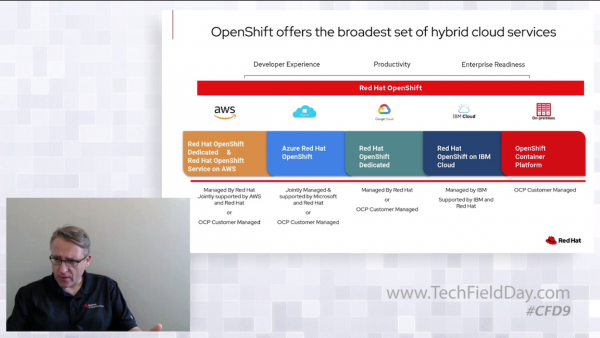Managing and operating Kubernetes at scale is complex. Even the best engineers can struggle to deploy Kubernetes and keep it running in a small environment. After the environment is running, a custom mix of monitoring, container registry, and support adds to the chaos. Most hyperscalers offer a managed Kubernetes option, though they don’t manage the day-to-day operations involved with running Kubernetes.
Red Hat addresses that issue with OpenShift Managed Services. Red Hat may not be the first name that comes to mind when you’re thinking about managed services, but they have managed OpenShift since 2015. This makes Red Hat one of the first Kubernetes managed service providers. Red Hat discussed their managed services options and competitive advantages in the cloud at Cloud Field Day 9.
Managed Kubernetes Options
Deploying a custom Kubernetes environment on-premises is difficult. Maintaining day-to-day operations is even more challenging. Everyone wants Kubernetes to orchestrate their applications, but few people understand the level of effort required to realize this goal.
Hyperscalers noticed the demand for Kubernetes and the operational difficulties customers faced. They responded by creating Kubernetes as a service. Amazon developed Elastic Kubernetes Service (EKS), and Microsoft launched Azure Kubernetes Service (AKS) to ease customers into consuming Kubernetes without needing to deploy it.
These services effectively lower the barrier of entry for their customers; however, the customers are responsible for their environment’s health. When there are problems in their application stack, the customer’s operations teams receive the alerts and are responsible for fixing the issues.
What is OpenShift?
Red Hat addresses the complexity of Kubernetes through OpenShift. OpenShift is an open-source platform-as-a-service offering that provides a full-stack development environment to the enterprise, simplifying operations and managing the environment’s lifecycle. It is developer-friendly, supporting multiple development languages.
The OpenShift platform simplifies multiple complexities involved with operationalizing Kubernetes, though it still requires care and feeding. Many customers want to offload all operations to a managed service, so Red Hat offers managed OpenShift to address their needs.

Managed OpenShift Reduces Complexity
Unlike other managed services, Red Hat manages the full spectrum of day-to-day operations. EKS or AKS still require monitoring and alerting managed by an in-house team. Amazon isn’t responsible for faults inside your EKS cluster. Your operations team will receive the page and be required to triage the situation. In a Red Hat OpenShift managed cluster, Red Hat receives the alert, their team triages the situation, and emails their customer with the incident’s details. The business’ Operations team can rest easy knowing their environment is in capable hands.
Red Hat offers three major Managed OpenShift offerings:
- OpenShift Dedicated
- Azure Red Hat OpenShift (ARO)
- Red Hat OpenShift Service on AWS (ROSA)
OpenShift Dedicated is installed and managed by Red Hat and provides enterprise-grade management and support on AWS or Google. This option is popular in businesses with OpenShift on-premises, as it can integrate into their existing authentication and tooling. The customers have the flexibility of choosing a region, node size, and their availability zone distribution. This service isn’t native to a given cloud provider and requires coordination with Red Hat to scale the service.
Azure Red Hat OpenShift is a fully managed OpenShift on Azure. It is engineered, operated, and supported by Microsoft and Red Hat. ARO provides an enterprise-grade 99.95% SLA and is PCI DSS, HITRUST, FedRAMP HIGH, SOC 2 Type 2, ISO 27001 compliant. It is a cloud-native application integrated directly into the Azure console. This integration allows a nimble, elastic consumption model managed by the engineering team.
Red Hat OpenShift Service on AWS (ROSA) is Red Hat’s most recent managed service option. As of this writing, it is in technical preview. Once it is released, it will appear in the AWS console beside the other container services. ROSA will provide flexible billing options native to AWS and a simple, scalable consumption model. It integrates natively with more than 170 AWS Cloud-native services, providing customers with the experience they expect from an AWS service combined with Red Hat OpenShift Managed Services’ operational excellence.
Conclusion
Kubernetes is as complex as it is powerful, and it is an enormous task to maintain operational excellence while focusing on keeping the lights on. Red Hat OpenShift managed services absorb the 24 hours per day, 7 days per week operational responsibility, allowing the business to focus on bringing value to their customers. Red Hat offers multiple options to meet customers where they are, helping them realize their business goals without the worries associated with Kubernetes. To learn more about Red Hat Managed Services, check out its videos from Cloud Field Day.




